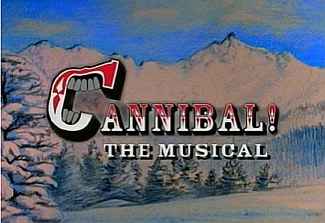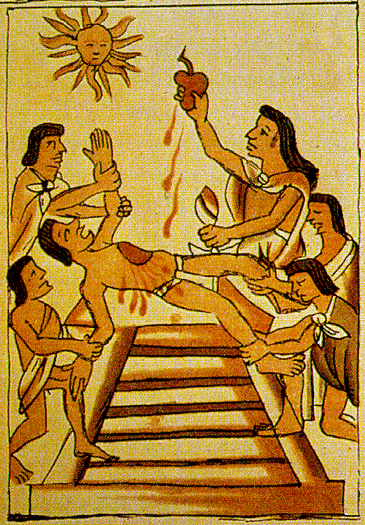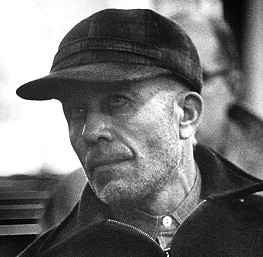|
Cannibalism There are so many, many bad things in the world, but for some weird visceral reason, cannibalism is considered just about the worst. Depending on your point of view, it rises above even such criminal abominations as pedophilia, rape and genocide, but in the final analysis, it's what's for dinner.
There are so many, many bad things in the world, but for some weird visceral reason, cannibalism is considered just about the worst. Depending on your point of view, it rises above even such criminal abominations as pedophilia, rape and genocide, but in the final analysis, it's what's for dinner.Then again, we live in a culture in which people would run vomiting to the bathroom if they saw what went into making their McDonald's hamburgers, in which a cow is brutally killed with blunt-force trauma, its innards are outered, and then the whole thing is ground up into a mealy paste, intestines, feces, bones and all. With McDonald's, you can mentally blank out the process in favor of focusing on the tasty fat-and-gristle laden product. With cannibalism, there is a nearly unavoidable tendency to linger on the details of the process—removing the limbs, peeling the skin, roasting it over an open flame, etc., etc. And do we really taste like chicken? Cannibalism is, of course, the eating of one's own species. It should be distinguished from vampirism, which is the drinking of human blood. If you cut a fellow human up into little pieces and puree him or her in a blender, that would technically be cannibalism and not vampirism. There are two kinds of cannibalism—sociological and pathological. The former means living and eating in a culture where cannibalism is accepted, and the latter means practicing cannibalism within a culture where it's not accepted.
In many cases, these charges were wholly fabricated. Reports of social cannibalism are mostly pointed at the Americas and Africa, since these were the primary continents subjected to European killing and conquest sprees from the Middle Ages through modern times. Despite the political convenience of these claims, there are documented examples of cannibalistic cultures and practices. There's no evidence that the Native Americans encountered in North America by the first European settlers had any history of cannibalism, although the accusation was repeated often enough. But there are some isolated examples that have been confirmed by recent research. Most demonstrable cannibal practices in North America were in the distant past, far earlier than Christopher Columbus sailed the ocean blue. In South America and Africa, there are more recent reports, or at least allegations. Unfortunately for the weak of heart, we're all descended from cannibals. Recent genetic studies revealed that almost all humans have genes designed to provide immunity to certain diseases which can only be transmitted by eating human brains. Based on what we know of recent tribal practices, it's generally thought that cannibalism was not treated like a night out at "Red Lobster," at least not within the time frame of the last 4,000 to 6,000 years. Instead, it usually was a spiritual ritual. In some cases, the bodies of enemies were consumed in order to absorb the enemies' strength; in other cases, the bodies of ancestors and relatives were consumed so that they would live on in the diners. One of the most recent discoveries of active cannibalism practice was the Fore tribe of Papua New Guinea, which was only discovered by Westerners in the 20th century. The Fores had turned to cannibalism only recently, to compensate for the meager sources of protein on the Pacific island where they lived. Woman and children ate brains for protein, while the men of the tribe caught their own small game. This was working out OK for them until a bizarre brain disease struck the tribe and created devastating casualties and eventually led to the abandonment of the practice.
Other famous alleged cannibals in anthropology include the Anasazi tribe in North America, the Aztecs in Central America, and on islands like Fiji, where the menu of choices was necessarily limited by geography. It should be noted that these claims are all extremely controversial because nobody likes to think about the topic. Having noted the controversy, feel free to subsequently ignore it, since most of the people arguing against cannibalism have been scientifically proven to be either a) recently descended from cannibals (and thus oversensitive) or b) idiots. Anthropology as a science is in deep trouble because anthropologists often find themselves persecuted for saying things people don't want to hear. If the anthropologists themselves ate each other, they would be subjected to less abuse than they get for saying long-dead cultures were cannibals. Cannibalism as a modern phenomenon is much more interesting and fucked-up than the historical record, at any rate. Modern cannibals are almost always really bizarre and unpleasant people, so consistently that when regular folks are driven to eat other by impending starvation, it invariably becomes the subject of a movie and at least 15 Discovery Channel sweeps-week specials. Examples of the latter include the soccer players whose plane crashed in the Andes and inspired the movie "Alive," and of course, the infamous Donner Party.
As this went on for some time, the members of the party became unbalanced. It was bad enough watching a spouse die; toasting him on a spit afterward didn't comfortably fit into the five stages of grieving. Some members went insane and killed other members. Normally this would be considered a tragedy, but for the Donner Party it meant a smorgasbord. The party was eventually rescued by spring; by the end half the party of 87 had died. One of the rescuers described the sight:
Among the cabins lay the fleshless bones and half-eaten bodies of the victims of the famine. There lay the limbs, the skulls and the hair of the poor beings who had died from want and whose flesh preserved the lives of their surviving comrades who, shivering beneath their filthy rags and surrounded by the remains of their unholy feast, looked more like demons than human beings. They had fallen from their high estate, though compelled by the fell hand of dire necessity.
The late Ugandan dictator Idi Amin Dada cannibalized most of his predecessor's underlings after a coup; 19th-century cannibal Alfred Packer later inspired Cannibal! The Musical (1996), an early film by the creators of South Park. The German cannibal Arwan Meiwes, who used Internet personal ads to find a victim, provided the basis for the recent musical smash All You Need (2004), as described by the San Francisco Chronicle:
All You Need has an air of youthfulness, with its rollicking live music, fresh-faced performers and quirkily episodic sensibility. [T]he wry tone sometimes recalls the radio show "This American Life" ... Sweeney Todd redux this isn't; [Director Erika] Shuch uses the metaphor of consumption to investigate all forms of desire. Jesse Howell and Jennifer Chien retread the "eat me" exchange as a tentative sexual proposition: "It's gonna hurt. ... It's not safe," they warn. An ensemble dance to the old standard "All of Me" takes on sinister shadings with the lines "take my lips ... take my arms."
The name of Ed Gein might be less well-known than Dahmer or Amin, but his work has taken on mythological proportions. Gein was the rural hick cannibal who inspired everything from Psycho (1960, 1998) to The Silence of the Lambs (1991), to The Texas Chainsaw Massacre (1974, 2003), in addition to to their countless sequels, prequels, spinoffs, and video game tie-ins.
And when you think about it, Jesus has some cannibalism issues of his own. Most Christians engaged in ritual cannibalism of Jesus on a regular basis, and the Catholic Church insists that their version is actual literal cannibalism, and not just a symbolic gesture. We had better not close out this discussion without answering the most pressing question everyone has about cannibalism: What do people taste like? We're assuming the taste of a hangnail doesn't carry over to the more succulent regions. Legend has it that spam tastes remarkably like human flesh [see Soylent Green]. Another popular comparison is pork, and of course we know everything "tastes like chicken." But let's go straight to a legit source. According to the Andean soccer team, "the slight browning of the flesh gave it an immeasurably better flavor, softer than beef but with much the same taste." So there you have it. I don't want to hear anymore of that pork crap.
cannibal world leaders
notorious incidents
cannibal killers
timeline
|
 There is a lot of controversy over the idea of sociological cannibalism, mostly because reports of its existence have been greatly exaggerated. Ever since human society expanded past the tribal stage, the charge of cannibalism has served as a primary justification for one social collective (European nation, Western religion, Aztecs) to annihilate another, usually militarily inferior social collective (aborigines, pagans, Mayans).
There is a lot of controversy over the idea of sociological cannibalism, mostly because reports of its existence have been greatly exaggerated. Ever since human society expanded past the tribal stage, the charge of cannibalism has served as a primary justification for one social collective (European nation, Western religion, Aztecs) to annihilate another, usually militarily inferior social collective (aborigines, pagans, Mayans).  Of course, social and recreational cannibalism is not just the province of non-white aborigines. In 15th century Scotland, a highlander named Sawney Beane and his wife lived in a remote mountain pass, where they subsisted on a steady diet of unfortunate travelers, which they also fed to their 14 children, and a number of
Of course, social and recreational cannibalism is not just the province of non-white aborigines. In 15th century Scotland, a highlander named Sawney Beane and his wife lived in a remote mountain pass, where they subsisted on a steady diet of unfortunate travelers, which they also fed to their 14 children, and a number of  The Donner Party was an expedition to the West Coast that had the misfortune of becoming stranded in a weekslong blizzard in the Sierra Nevada area. Lost in the mountains of California for nearly two months, they ran out of food and began to die. The company drew lots to determine who would be dinner, but then "didn't have the heart" to kill him. Luckily, he died from illness anyway. They skinned him, cut the meat from his bones and roasted it. When that ran out, they discussed murdering their Indian guides for dinner (apparently, they had the heart for that). The guides wisely took their chances with the blizzard, however they didn't make it far enough and ended up au jus.
The Donner Party was an expedition to the West Coast that had the misfortune of becoming stranded in a weekslong blizzard in the Sierra Nevada area. Lost in the mountains of California for nearly two months, they ran out of food and began to die. The company drew lots to determine who would be dinner, but then "didn't have the heart" to kill him. Luckily, he died from illness anyway. They skinned him, cut the meat from his bones and roasted it. When that ran out, they discussed murdering their Indian guides for dinner (apparently, they had the heart for that). The guides wisely took their chances with the blizzard, however they didn't make it far enough and ended up au jus.  Cannibalism isn't just about survival, though. There have been plenty of non-survival cases of cannibalism reported in recent years.
Cannibalism isn't just about survival, though. There have been plenty of non-survival cases of cannibalism reported in recent years.  Outside the Western world, Chinese performance artist Zhu Yu made a name for himself by eating a dead baby on film. It's not clear what the artistic merit of this act was supposed to be, but we're sure there must be some. The photo shown here prompted a massive furor about the Internet and art, as well as inspiring a purported "investigation" by the
Outside the Western world, Chinese performance artist Zhu Yu made a name for himself by eating a dead baby on film. It's not clear what the artistic merit of this act was supposed to be, but we're sure there must be some. The photo shown here prompted a massive furor about the Internet and art, as well as inspiring a purported "investigation" by the  There have been more movies about Ed Gein than Plato. For that matter, Ed Gein is serious competition for
There have been more movies about Ed Gein than Plato. For that matter, Ed Gein is serious competition for